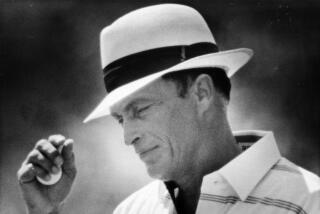MUSIC AND DANCE REVIEWS : SANTIAGO RODRIGUEZ AT AMBASSADOR
- Share via
Cuban-born, Juilliard-trained pianist Santiago Rodriguez can galvanize even repertory staples, and not simply through digital dazzle. In fact, Saturday night in his fourth appearance at Ambassador Auditorium it was his truly noble vision of the much-abused Funeral March that refreshed Chopin’s B-flat minor Sonata, since melodic direction often dissolved in a rush of figuration in high-velocity passages.
Mozart’s Sonata in C, K. 330, displayed Rodriguez’s control of touch and articulation. He could draw any sort of sound, at any speed, from his brilliant, clear Baldwin, but marred the effect with moments of overstated rubato. He prefaced a second half otherwise devoted to Hispanic music with Phillip Lambro’s Toccata (1965). This is what Gottschalk’s “Banjo” would have been, had it been written for the head as well as for the hands.
Three Argentinian Dances by Ginastera provided a 20th-Century counterpoise to the Chopin Sonata. The outer dances are fast, heavily accented affairs, surrounding an unhackneyed distillation of lyric sentiment. Rodriguez again projected fury as ably as soulful song.
Finely scaled dynamic schemes, melodic flair and clean, propulsive drive characterized a Lecuona group, which reminded us that the Cuban bandleader’s popularity was solidly based. Rodriguez gave a sparkle even to “Malaguena.”
A Soler Sonata, Falla’s “Andaluza” and “Oriental” by Granados showed some of the stylistic variety within music still identifiably Iberian. Rodriguez preserved the integrity of these substantial pieces while delivering their full measure of evocative color. Vociferous applause produced two encores.
More to Read
The biggest entertainment stories
Get our big stories about Hollywood, film, television, music, arts, culture and more right in your inbox as soon as they publish.
You may occasionally receive promotional content from the Los Angeles Times.










